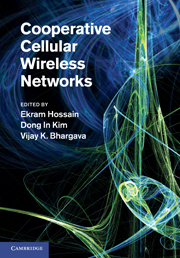Book contents
- Frontmatter
- Contents
- List of contributors
- Preface
- Part I Introduction
- Part II Cooperative base station techniques
- Part III Relay-based cooperative cellular wireless networks
- Part IV Game theoretic models for cooperative cellular wireless networks
- Part V Standardization activities
- 15 Cooperative communications in 3GPP LTE-Advanced standard
- 16 Partial information relaying and relaying in 3GPP LTE
- 17 Coordinated multipoint transmission in LTE-Advanced
- Index
15 - Cooperative communications in 3GPP LTE-Advanced standard
from Part V - Standardization activities
Published online by Cambridge University Press: 03 May 2011
- Frontmatter
- Contents
- List of contributors
- Preface
- Part I Introduction
- Part II Cooperative base station techniques
- Part III Relay-based cooperative cellular wireless networks
- Part IV Game theoretic models for cooperative cellular wireless networks
- Part V Standardization activities
- 15 Cooperative communications in 3GPP LTE-Advanced standard
- 16 Partial information relaying and relaying in 3GPP LTE
- 17 Coordinated multipoint transmission in LTE-Advanced
- Index
Summary
Introduction
A cellular communication system is designed based on the concept of frequency reuse, in which the same frequency resources are reused at a certain distance from a cell site. Traditionally, a cellular system has been composed of cell sites operating independently except in some inevitable scenarios like handover. Independent operation of each cell site makes it possible to deploy a wireless system at a low cost, while maintaining the quality of the voice service. However, due to the large amount of interference from neighboring cell sites, cell-edge users experience bad channel conditions. Furthermore, the cell-edge interference becomes more severe, when the frequency reuse factor is 1, which is a common assumption for cellular systems designed for high capacity. Therefore, with the conventional cellular designs, it is difficult to achieve high data throughput for users located at cell edges.
However, as the need for high-speed data communication increases, cooperative communications between the neighboring cell sites and UEs are being more intensively studied not only in academia but also in industry. One of the main focuses of these studies is to increase the data throughput for the cell-edge UEs. To increase the throughput of the cell-edge UEs, neighboring eNodeBs cooperate to enhance the signal quality and/or decrease the interference level. Coverage extension through a wireless relay is another research focus of cooperative communication. Interference management and cooperation between eNodeBs are important issues in a heterogeneous network.
- Type
- Chapter
- Information
- Cooperative Cellular Wireless Networks , pp. 425 - 461Publisher: Cambridge University PressPrint publication year: 2011
- 2
- Cited by



